Affiliate disclosure: This post may contain affiliate links. Please see our Privacy Policy.
Dandelion wine captures the essence of summer. Sweet, floral and with subtle notes of honey, dandelion wine is tasty enough to bring out the forager in anyone. It takes quite a few dandelions to make wine, so it’s best to enlist the help of as many small children as possible.
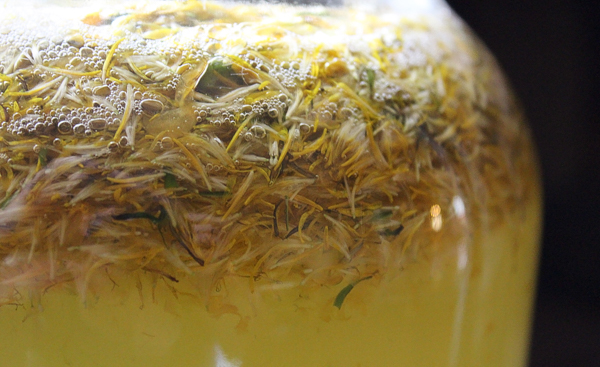
The author of Backyard Medicine talks about how her very first job as a child was collecting dandelions for her neighbor’s dandelion wine. He paid her by the paper sack full and she was happy to do it.
The first time we made dandelion mead, a type of dandelion honey wine, I enlisted the help of a 4-year-old neighbor girl. She picked enough dandelions for a 5-gallon batch in about an hour.
After that, every time I saw her for the rest of the summer she would bring me dandelions. That little neighbor girl is a teenager now, and I have my own daughter to lend a hand.
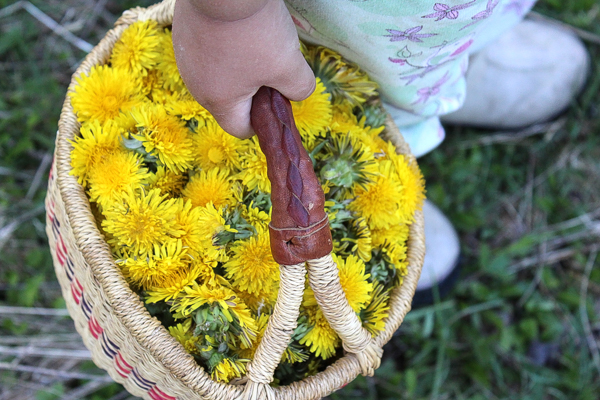
The real work in making dandelion wine is not collecting the dandelions. It’s in splitting apart the dandelions and removing the green leaves from each blossom. The green leaves have a milky sap that will ruin the taste of dandelion wine, and a good batch only uses the petals.
This year, my 3-year-old daughter picked about a gallon of blossoms in about 15 minutes, but we spent over an hour picking the petals from the flower heads.
It’s pleasant work for a warm afternoon, and I had my best girl sitting across from me. I successfully bribed her for the task by promising that some of the blossoms would be used to make dandelion ice cream.
(Since then I’ve bribed the littles with dandelion cookies, dandelion marshmallows, and even dandelion gummy bears…there’s a reason I have so many dandelion recipes in my back pocket…and that reason is wine!)
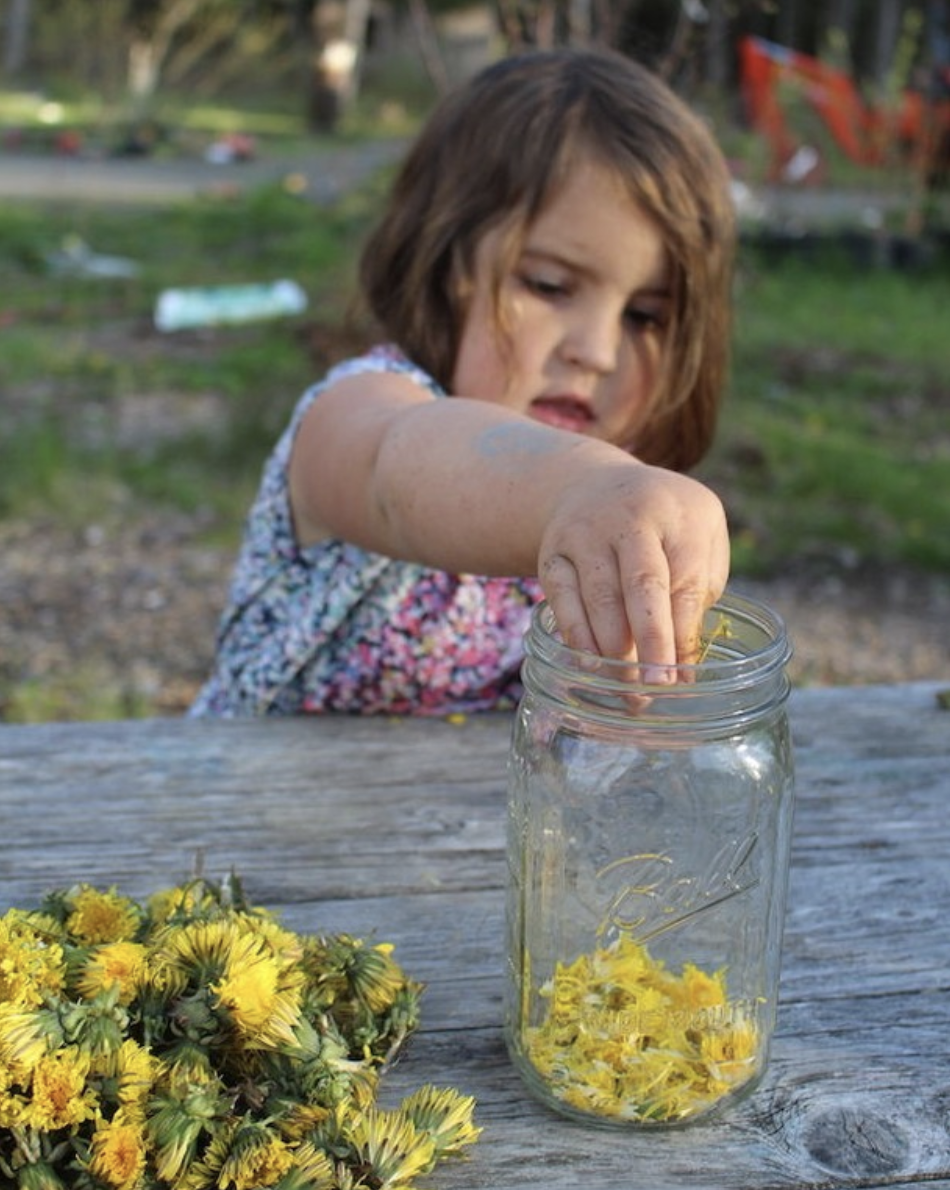
Given that it’s a bit labor-intensive to clean dandelion flowers for wine, plan on making a small batch.
You can make a 5-gallon batch in a traditional carboy, but unless you’ve got a lot of devoted friends, your fingers will likely give out before you have enough dandelion petals.
I had originally planned to make a super tiny 1-quart batch in a quart mason jar. It’s easy enough to attach a mason jar fermentation kit and brew on a very tiny scale.
In the end, we made better progress than I’d anticipated and ended up with enough petals for a full one-gallon batch of dandelion wine.
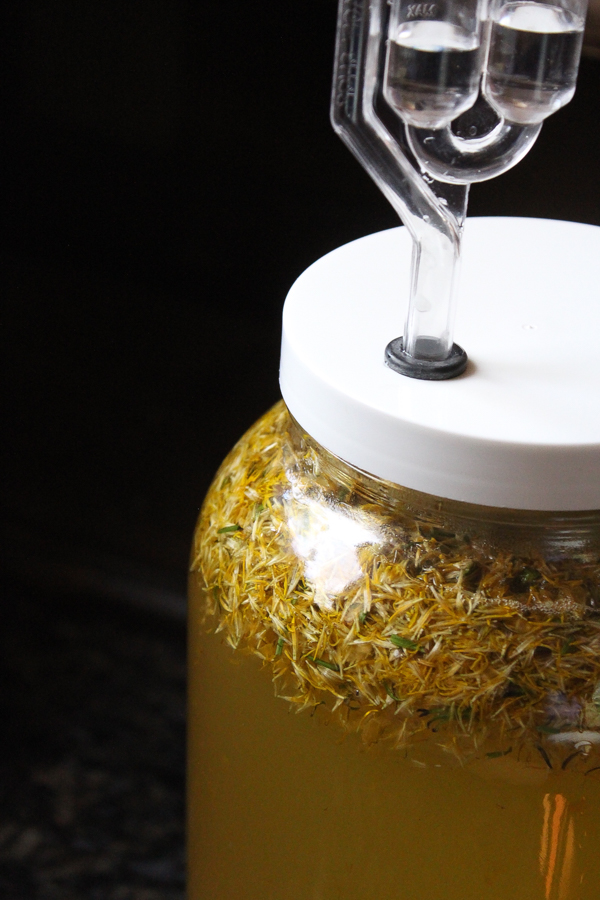
That means I get to try out my new wide mouth one-gallon carboy. If you’ve ever tried to clean out a narrow neck carboy after you’ve brewed with flower petals or any other small particulate, you’ll understand why the wide mouth is so convenient.
Dandelion petals will glue themselves to the inside of the neck of your fermentation vessel and you’ll be scrubbing with a bottle brush for a while unless you use something big enough to get a hand into.
After the primary ferment, the dandelion petals need to be filtered out as the wine is racked into a clean secondary fermentation vessel.
The wide mouth on this fermenter makes that an easy job, and you can just scoop the floating flower petals off the surface before racking.
Racking is a winemaking term, but it just means transferring the wine to a new clean container while leaving the sediment at the bottom behind. This is often done with a siphon for the best results, but it can be done by just pouring the wine carefully into a new container.
It helps to have 2 fermentation vessels, so there’s a clean one waiting, but lacking that, pouring the dandelion wine into a pair of half-gallon mason jars temporarily while you wash out the fermenter works too.
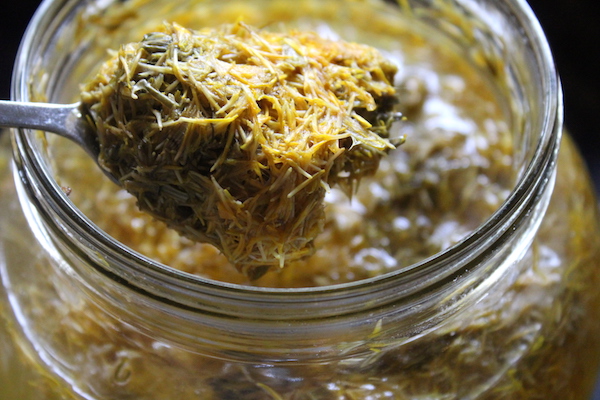
This dandelion wine is made using a cold infusion, which means that the sugar syrup goes in cold, and more of the floral flavor of the dandelions is preserved in the final wine.
You can just make a dandelion tea and filter out the petals before brewing, but the hot water used to make the tea will drive off some of the volatile flavors of the dandelions, and the resulting wine will taste a bit different.
Still, making a tea is much cleaner than brewing with flower petals in the fermenter, and you won’t run the risk of the flower petals bubbling up into the airlock and clogging up the works. If that does happen, just take off the airlock and clean things out before putting it all back together.
If you’re lacking a siphon or other brewing equipment, you can simply brew up this dandelion wine in a pair of half-gallon mason jars equipped with inexpensive silicone water locks. Once the primary ferment is over, scoop off the dandelion petals and carefully pour the wine through a fine mesh strainer into the secondary, leaving the sediment behind.
Reattach a water lock and you’re good to go until bottling time.
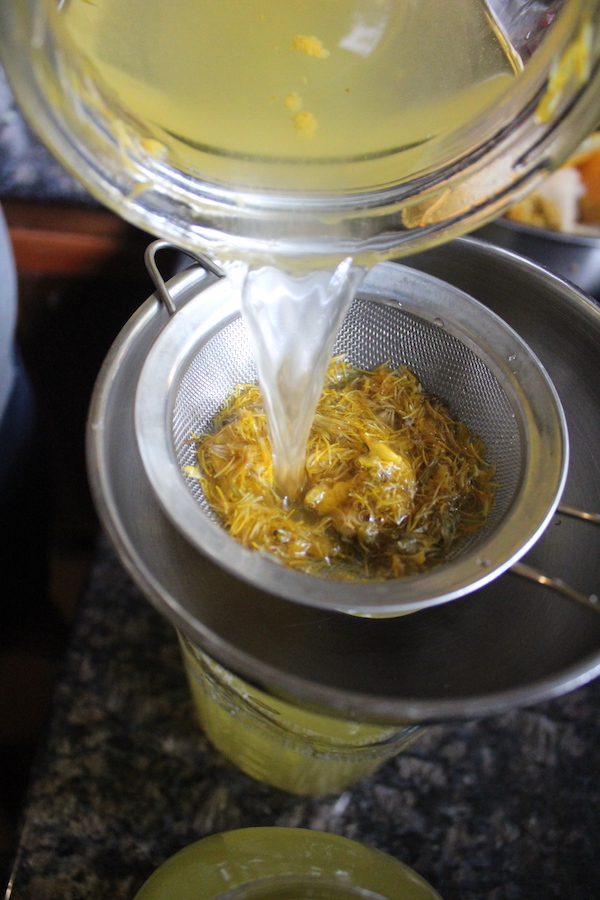
The final wine has a cleaner flavor if you don’t add raisins to the batch, but the yeast work more efficiently with either a few raisins in the wine to provide micro-nutrients that are missing from plain table sugar.
You can also add 1 teaspoon of yeast nutrient to the dandelion wine which will provide nutrients for the yeast without changing the flavor of the finished wine.
That’s really the best solution for the best dandelion wine quality.
How Does Dandelion Wine Taste?
If you’ve done it right, a propper dandelion wine tastes sweet, mild, and floral. You can almost feel the sunshine splash against your tongue, and it goes down smooth with no hints of bitterness.
We tried this batch in January, after about 6 months in the bottle and it was just right. More importantly, it was just what I needed on a cold Vermont evening, with more snow in the forecast and several feet already down on the ground.
Spring will come again, and sipping this little beauty brings me hope.
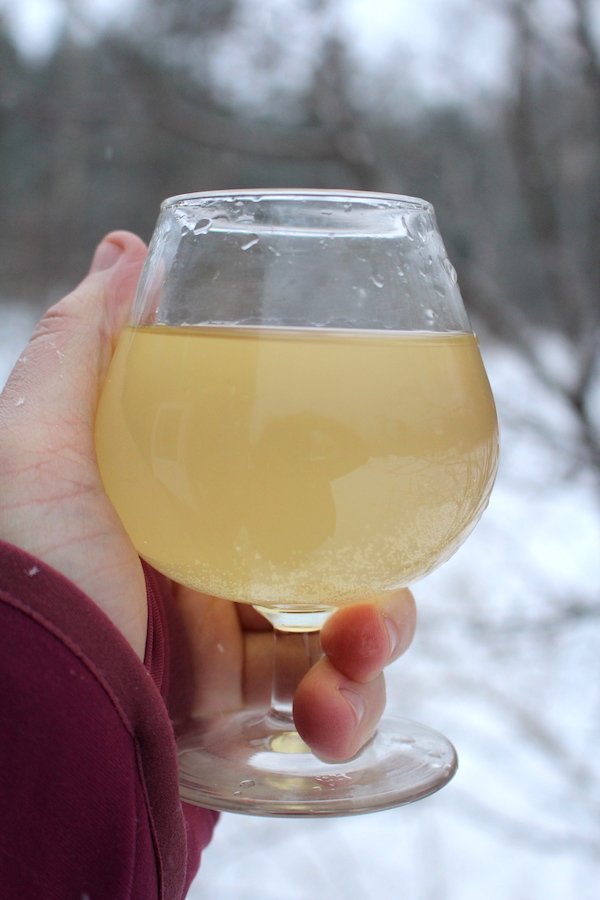
Winemaking Recipes
Looking for more ways to fill your glass with homemade wine?
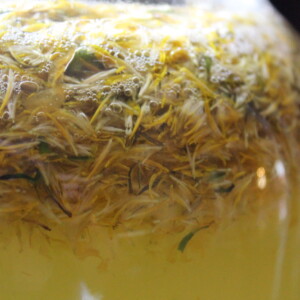
Dandelion Wine
Equipment
Ingredients
- 3 quarts water, approximate, more to fill
- 3 pounds sugar , roughly 5 to 6 cups
- 1- quart dandelion petals, packed from roughly 3-4 quarts blossoms
- 3 medium oranges, juice and zest
- 1 medium lemons, juice and zest
- 1 tsp yeast nutrient
- 1 packet wine yeast
Instructions
- Bring the water and sugar to a boil in a saucepan. Stir to dissolve the sugar and cool to lukewarm.
- Place the dandelion petals, citrus juice and zest into a one-gallon fermentation vessel. Add the yeast nutrient and pour the lukewarm sugar water over the top.
- Dissolve a packet of champagne yeast or other wine yeast in lukewarm water. Allow it to stand for 5 minutes to rehydrate and then pour it into the wine. Top off with a bit of extra water to bring to fill the carboy, but be sure to leave at least an inch of headspace.
- Cap with an airlock and ferment for about 3 weeks or until fermentation has stopped. It will take a bit longer if you don’t use raisins because they provide extra micro-nutrients to get the yeast working faster.
- Siphon the wine into a clean container, leaving the yeast sediment behind. Allow the wine to ferment in secondary for at least 6 to 8 weeks, checking the water lock periodically to ensure that the water hasn’t evaporated.
- Sciphon the dandelion wine into a clean container, again leaving the sediment behind, to prepare for bottling.
- Bottle the dandelion wine in corked wine bottles for longer storage, or flip top Grolsch bottles for tiny batches you’re not planning on storing long.
- Allow the wine age in the bottle at least 2 months before drinking, ideally 6 months or more. Note: During aging, the wine should be kept somewhere cool-ish like a basement or closet on the north side of the house.
Nutrition
Nutrition information is automatically calculated, so should only be used as an approximation.
Small Batch Dandelion Wine
If you’d like to make dandelion wine without investing a lot of time, divide the recipe by 4 to make a super small 1-quart batch. It’s a great solution for those that just want to try it, but don’t want to spend all day plucking apart petals.
All you need is a quart mason jar and a mason jar fermentation kit.
A full packet of champagne yeast will be overkill in a quart batch, so be sure to only use about 1/4 of a packet. Save the rest for another small batch brew, and maybe give small-batch mead a try with any of these mead recipes.
More Dandelion Recipes
Fun Facts…There’s actually a Ray Bradbury novel titled Dandelion Wine, where the drink serves as a metaphor for packing all the joys of summer into a single bottle. How’s this for nostalgia…
“The summer of ’28 was a vintage season for a growing boy. A summer of green apple trees, mowed lawns, and new sneakers. Of half-burnt firecrackers, of gathering dandelions, of Grandma’s belly-busting dinner. It was a summer of sorrows and marvels and gold-fuzzed bees. A magical, timeless summer in the life of a twelve-year-old boy.”
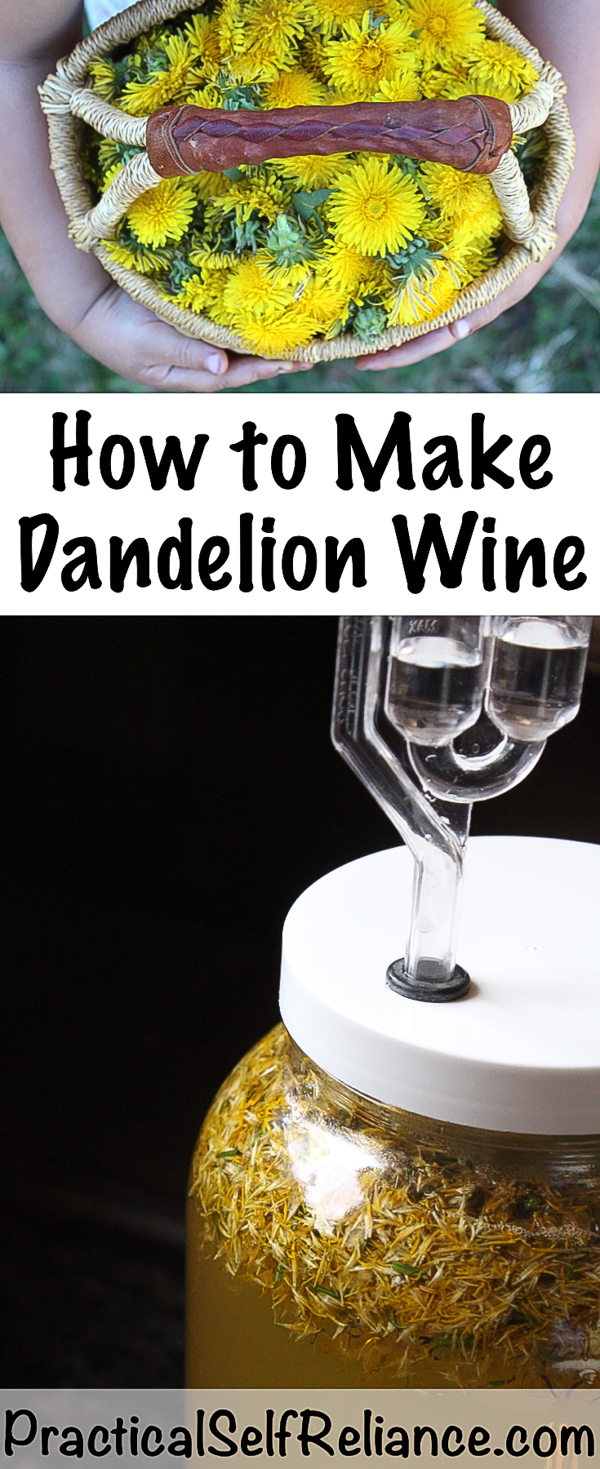
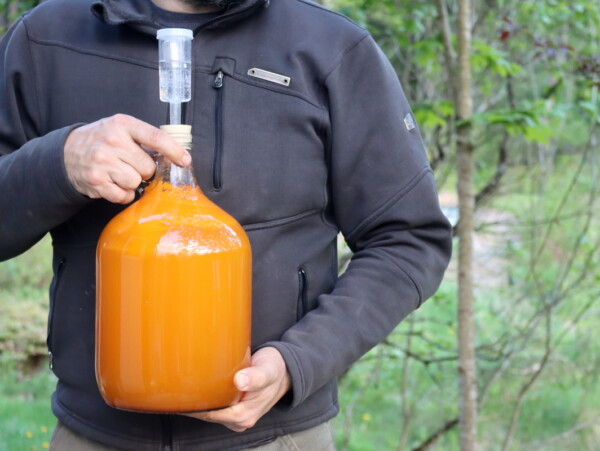



Hi! This is my first attempt at home brewing. Can you please tell me the ideal temperature the first ferment should hover around? I’ve currently got it in a dark closet on the north side of our house, but it’s not super bubbly in the airlock and context from other comments implies that perhaps it should be…?
Any advice you can offer would be great. My Google-fu is failing me on this one.
It depends on the type of wine. It is recommended that red wines ferment between 68 and 86 degrees F and 59 or below for white whines. For Dandelion wine, most people ferment at standard room temperature, or somewhere between 65 and 75 degrees.
I made wine with marmalade(pectin) or you can use molasses. adding processed sugar makes the wine unhealthy. especially 5 pounds wtf.
The recipe actually calls for 3 pounds of sugar rather than 5. Anywhere from 1 to 3 pounds of sugar per gallon is very standard. Of course it’s totally up to you which kind of sugar your choose to use, but many people prefer table sugar since it has a more neutral taste and doesn’t interfere with the taste of the wine.
Hi, thanks so much for this great recipe! When I transferred the batch to the secondary container, I left the sediment out as specified and now it’s not bubbling in the airlock at all. Should I worry? Do I need to add anything? Thank you!
How long did you leave it before racking into the secondary container. Had the fermentation stopped before you transferred it?
Hi I just came across this post. I have a question, is it necessary to use yeast. What if I have on hand my own homemade fermentation starters made from fruit can I use that in replacement of the yeast?
You must have yeast to make wine. The difference is where that yeast comes from. You can innoculate your wine with cultured yeast like described in this post or you can use wild yeast that is in the air and allow it to spontaneously ferment. It really depends on your personal preference. Spontaneous fermentation can be very unpredictable which doesn’t necessarily mean it’s bad. You just need to do your own research and determine which method is best for you. Here is an article that I found that explores the pros and cons of each method. https://winemakermag.com/article/758-wild-yeast-the-pros-and-cons-of-spontaneous-fermentation#:~:text=Whether%20you%20are%20a%20first,produces%20alcohol%20and%20carbon%20dioxide.
I just made this recipe this year and its delish!
My friend and I are trying to brainstorm new flavors and we were thinking of trying rose. Could you just substitute rose petals for the dandelion? Maybe not use as much citrus? Any suggestions ?
Rose sounds amazing, and I’ve actually considered that option too, but haven’t quite caught enough of our wild roses at peak bloom to make it happen. Less citrus sounds about right, or at least skip the orange and go with all lemon. For a more neutral taste, you can also use acid blend, which is formulated for brewing and will get the pH right without adding citrus. You might try basing the recipe off this lilac wine recipe for roses (https://practicalselfreliance.com/lilac-wine-recipe/). This recipe uses blueberries or blackberries for color, though I think a splash of pomegranate juice or raspberry juice might really compliment roses. Best of luck and let me know how it goes!
Finding enough Roses was also a hurdle we thought we’d face, I never thought of lilac! Much more accessible
Hi, Ashley. I am ready to rack my wine after it’s second fermentation process but I was wondering if it’s okay that the leftover yeast in the bottom is dark and dead looking? My wine is also a bit dark in color. Also, my siphon turns out to be plastic and I can’t find a recommendation for a sanitizer for it. Do you recommend a particular sanitizer or a way to sanitize it?
Use something called one-step sanitizer for your siphon, it’s the same thing I use for everything. Dark colored lees at the bottom is totally fine and normal.
Essentially an update of how it is going…
In the height of the lock down I figured I would give it a go. SInce I have a 5 gallon kit, of course I wanted to make 5 gallons and used your recipe. It took a long time to gather all those petals! Recipes online seem to vary from 1-3 qts of petals per gallon of water. I only found one example where it was done by mass which was 75 g of petals per liter of water (essentially a qt). The way I packed the petals it worked out to about 2 qts/gallon.
Using the yeast nutrient and champagne yeast, after just over two weeks in primary ferment I transferred into a carboy with air lock. It still bubbles a couple times a minute so maybe I did it a bit early but maybe not. Hydrometer readings from the start and end of the two weeks showed an alcohol content reaching ~18% which is just about the limit of my yeast.
Right now it is a cloudy When I siphoned into the second vessel. As you can see it is quite cloudy and orange/yellow. I took the opportunity with the wine thief to give it a taste. Fairly strong alcohol taste but quite a sweet taste, almost like a liqueur. Not at all unpleasant. Right now it seems to have a yeasty (to be expected) citrus/orange flavor. I have never had dandelion wine for comparison but I am hoping after secondary fermentation and bottle aging I will get the dandelion flavor. If not, it will still be good.
If it does stay too citrusy it is probably because I didn’t take into account the volume of the juice and petals in the vessels and went with 18 oranges, 6 x lemons for 5 gallons of water.
It looks and sounds like it’s coming along great. The flavor will only improve with age!
If I don’t have exactly enough petals right now, do you think I could dry them out and keep gathering, until I gave enough? Thanks so much, I can’t wait to make it.
Kandace Lee
I’ve kept them in the fridge, plucked from their stems, for up to a week without issue. Other’s I’ve read have frozen them until they had enough. I don’t know about drying, but that may work well too (or it may rob them of flavor). Good luck!
Hi Ashley, I’m impatiently making my first batch of dandelion wine. After almost 5 weeks it is still on its first fermentation with the airlock “burping” every 1-2 seconds. I have kept it in a cool basement of about 65 degrees. Should I go ahead and rack it to get the petals out of it? Do you ever clean the airlock? Thanks in advance for any advice. I’m so afraid that the petals will go bad and ruin the wine.
Yup, I’d take everything out and clean the air lock at this point. A cool basement is a great spot for it, it’ll ferment much slower, but with a slower more gentle ferment you’ll get better flower flavor (rather than things volatilizing off). But yes, it’s time to filter them out and clean the water lock.
Thank you for responding to all these comments! I I’m trying this for the first time. I just moved into the second fermentation and I have 2 gallon carboys, but one of them is quite clear and (I tasted it) VERY sweet while the other is cloudy and VERY alcoholic tasting. Should I bail on one of these? Or let them both sit in second fermentation for 6-8 weeks?
They both were very active very quickly and I’m afraid they sat for many more weeks in their first fermentation than was necessary, too. They were in my kitchen for 3 weeks but I think fermentation may have finished after just a couple days…
I often forget things in primary for way too long, no worries, it happens. The sweet one will likely need more time, assuming it’s active. If it’s not bubbling, then the yeast may be dead and that one may need fresh yeast added. The really alcoholic tasting one will mellow in the bottle, assuming it’s still has enough sugar left to balance it (if it tastes sour now along with alcoholic then you may need to add more sugar for taste). Did you use the same recipe for both? That’s a pretty dramatic difference between the two…
Do you ever use camden tablets in your recipes
I don’t actually, but many people always do. You can make fine wine without adding camden tablets if that’s your choice.
How do I know when it is time to rack the wine? Do I just wait for 3 weeks to go by? Do I watch to see if there are no bubbles in the air lock for a certain amount of time? My carboy is in a cool basement. Thank you so much for sharing your recipe and experience! I’m very excited about this.
Usually a few weeks is good, maybe 3-4 weeks at most in colder spots. You want to get the petals out of there sooner rather than later because they can mold. A good rule of thumb is to wait 3-4 minutes between airlock bubbles, but you may just never get there. Don’t leave the petals in for more than 3-4 weeks in any case.
Hi there! In the comments to another question you mentioned making pineapple wine. I searched your website for a recipe and couldn’t find one. Do you have a recipe for pineapple wine? I’d love to try it!
I do have a recipe, but it’s not posted yet. Hopefully soon. It comes from the book Artisanal Small Batch Brewing. She uses bottled pineapple juice, but I substituted fresh pineapple juice that I extracted myself.
Hi there,
We followed your recipe but have still not seen any bubbling in the airlock. It’s been 10 days. We didn’t wait until the boiling mixture reached room temp before adding the yeast mixture, I’m thinking it’s possible it could have died if the mixture was too hot? Can we add more yeast at this point? Thanks!
If it’s been more than 48-72 hours with no bubbles, I’d assume something happened to your yeast. You may still be able to save it if you pitch yeast now, but 10 days in, something else may have colonized in there and if may have already spoiled. Give it a smell, and if it still smells fine, maybe try to re-pitch the yeast and save it. Use your best judgment though.
Your recipe doesn’t say anything about removing the dandelion petals, etc. Do they stay in the fermenter for 3 weeks?
Yes, the petals stay in the wine through primary fermentation, but they’re filtered out before secondary fermentation.
I’m excited to try my first batch of dandelion wine (first home brew experience ever!).I read through your overview on making small batch wine, which mentioned the need for tannins, but this recipe doesn’t mention that. Is it not necessary for dandelion wine? Thanks! I just discovered your blog and it is so chock full of great things!
Tannin is optional in any winemaking recipe, and it affects the final flavor and mouthfeel, but not how it ferments. For some reason it’s never included in dandelion wine recipes, maybe the petals have some naturally? Anyhow, while I often add it to other fruit wine recipes, I didn’t add it here because way back in the day when I made my first batch the recipe didn’t have it. It turned out great, so I’ve never added it since.
Hi Ashley,
I just want to say THANK YOU for EVERYTHING! I was SO happy to have found your site so I could try my hand at Dandelion winemaking. I remember picking the blossoms for my older sister as a youngster & having a tiny taste of her delicious wine, but I had no CLUE what she did or how she did it & since she has passed years before I could even ask her, I thought the process was just forever lost. Imagine my delight at finding your wonderful information! I’m starting my process today…. 😊 We’ll see what happens!
Hi Ashley, just wondering about something… I tried to do the primary ferment in a carboy (narrow neck), but it began overflowing, so I moved everything into a wide-mouthed glass container and put a towel over it for 2-3 days to give it some time to calm down. Then I transferred the liquid back into the carboy, filtering out the pedals & orange and lemon peels… It didn’t occur to me at the time, but now I’m wondering if I removed the pedals & zest too soon. Is 2-3 days enough time to extract enough flavor into the wine? Or should I have put all the contents back into the carboy for the remainder of the first ferment? How long do you typically leave the pedals & zest in?
That should be totally fine. The vast majority of the flavor comes out in the first day or two. Good luck with your wine!
For a five gallon batch do I use more than one packet of champagne yeast?
Yup! One packet is good for up to 5 gallons.
My house, at night, gets down to 60 degrees. We are abut to hit day temps that will consistently be in the mid-60s to 70 range. Do you think it’s OK to start a batch? This is my first try!
Sounds perfect.